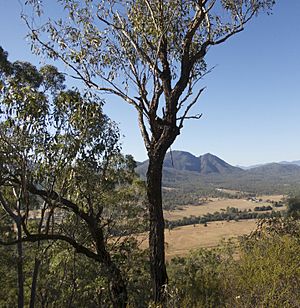Eucalyptus dura facts for kids
Quick facts for kids Eucalyptus dura |
|
|---|---|
 |
|
| Eucalyptus dura on Mount Greville | |
| Scientific classification | |
| Genus: |
Eucalyptus
|
| Species: |
dura
|
The Eucalyptus dura is a special kind of tree, usually small to medium in size. It grows only in south-eastern Queensland, Australia. This tree is easy to spot because of its rough, dark grey to black bark, which looks like iron! It also has long, narrow leaves, white flowers that grow in groups of seven, and cone-shaped fruits.
Contents
What Does It Look Like?
The Eucalyptus dura is a tree that can grow up to 25 meters (about 82 feet) tall. It has a special woody swelling at its base called a lignotuber, which helps it regrow after fires.
Its main trunk and bigger branches are covered in dark grey to black "ironbark." This bark is very rough and tough. However, the smaller branches, less than 30 mm (about 1 inch) thick, have smooth bark that is grey or cream-colored.
Leaves
Young Eucalyptus dura plants have leaves that are shaped like a spear or an egg. These leaves are usually 95 to 140 mm (about 3.7 to 5.5 inches) long and 20 to 40 mm (about 0.8 to 1.6 inches) wide.
When the tree gets older, its adult leaves become lance-shaped (like a spearhead) and sometimes a bit curved. They are usually 90 to 180 mm (about 3.5 to 7 inches) long and 15 to 33 mm (about 0.6 to 1.3 inches) wide. Each leaf has a stalk called a petiole, which is 10 to 35 mm (about 0.4 to 1.4 inches) long. Both sides of the leaves are a shiny green color.
Flowers and Fruit
The flowers of the Eucalyptus dura are white. They grow in groups of seven on the ends of the tree's small branches. Each group of flowers is on a main stalk called a peduncle, which is 7 to 25 mm (about 0.3 to 1 inch) long. Each individual flower bud also has its own tiny stalk, called a pedicel, which is 4 to 8 mm (about 0.16 to 0.3 inches) long.
When the flower buds are ready to open, they are oval or pear-shaped. They are about 7 to 9 mm (about 0.28 to 0.35 inches) long and 4 to 5 mm (about 0.16 to 0.2 inches) wide. Each bud has a cone-shaped cap called an operculum. This cap is narrower and shorter than the base of the flower, which is called the floral cup.
Eucalyptus dura trees mainly bloom from April to June. After the flowers, the tree produces woody, cone-shaped fruits. These fruits are called capsules and are 6 to 10 mm (about 0.24 to 0.4 inches) long and 5 to 7 mm (about 0.2 to 0.28 inches) wide. They sit on a pedicel that is 2 to 10 mm (about 0.08 to 0.4 inches) long. The parts that open to release the seeds are below the edge of the fruit.
Tree Name and History
The Eucalyptus dura was officially described for the first time in 1991. Two scientists, Lawrie Johnson and Ken Hill, studied a sample collected from Turkey Mountain in the Barakula State Forest in 1984.
The second part of its scientific name, dura, comes from a Latin word. "Dura" means "hard" or "tough," which perfectly describes the tree's strong, rough bark!
Where Does It Grow?
This ironbark tree likes to grow in grassy areas and dry forests. You'll usually find it in sandy soil and on higher ground. It grows in south-east Queensland, in an area between the towns of Biggenden, Chinchilla, and Boonah.
What Is It Used For?
Essential Oils
The leaves of the Eucalyptus dura tree are full of special oils. These are called essential oils. They contain substances like beta-phellandrene and 1,8-cineole. Scientists think these oils might be useful for making a bacteriostat. A bacteriostat is something that can stop bacteria from growing.
Images for kids




